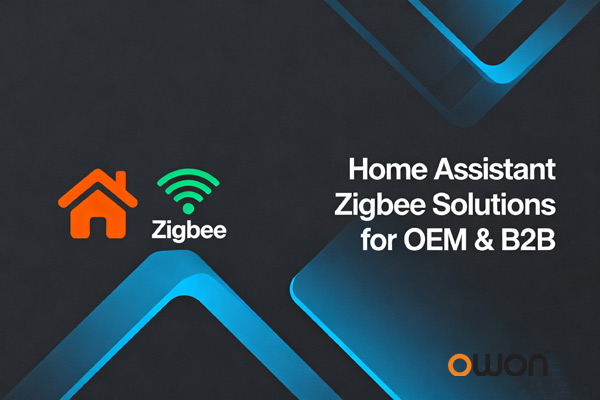Introduction: Why “Home Assistant Zigbee” Is Transforming the IoT Industry
As smart building automation continues to expand globally, Home Assistant Zigbee has become one of the most searched technologies among B2B buyers, OEM developers, and system integrators.
According to MarketsandMarkets, the global smart home market is projected to reach over USD 200 billion by 2030, driven by wireless communication protocols like Zigbee that enable low power, secure, and interoperable IoT systems.
For manufacturers and distributors, Zigbee-enabled devices — from smart thermostats and power meters to door sensors and sockets — are now essential components in modern energy management and building control solutions.
Section 1: What Makes Zigbee Home Assistant So Powerful
| Feature | Description | Business Value |
|---|---|---|
| Open Protocol (IEEE 802.15.4) | Works across brands and ecosystems | Ensures compatibility and future scalability |
| Low Power Consumption | Ideal for battery-operated IoT devices | Reduces maintenance costs for facility managers |
| Mesh Networking | Devices communicate with each other | Extends network coverage and reliability |
| Local Automation | Runs locally within Home Assistant | No cloud dependency — improved data privacy |
| Integration Flexibility | Works with energy, HVAC, lighting systems | Simplifies cross-platform control for B2B customers |
For B2B users, these features mean lower integration cost, higher reliability, and faster deployment in commercial environments — such as hotels, office buildings, and smart energy grids.
Section 2: Zigbee vs Wi-Fi – Which Is Better for Smart Building Projects?
While Wi-Fi is excellent for high-bandwidth applications, Zigbee dominates where reliability and scalability matter most.
| Criteria | Zigbee | Wi-Fi |
|---|---|---|
| Power Efficiency | ★★★★★ | ★★☆☆☆ |
| Network Scalability | ★★★★★ | ★★★☆☆ |
| Data Throughput | ★★☆☆☆ | ★★★★★ |
| Interference Risk | Low | High |
| Ideal Use Case | Sensors, meters, lighting, HVAC | Cameras, routers, streaming devices |
Conclusion: For building automation, Zigbee-based Home Assistant systems are the smarter choice — offering energy efficiency and robust local control critical for commercial deployments.
Section 3: How B2B Customers Use Zigbee Home Assistant in Real Projects
-
Smart Energy Management
Integrate Zigbee power meters, smart sockets, and CT clamps to monitor energy usage in real time.
→ Ideal for OEMs designing residential solar or EV charging systems. -
HVAC and Comfort Control
Zigbee thermostats, TRVs, and temperature sensors maintain optimal comfort while saving energy.
→ Popular among hotels and facility managers adopting ESG goals. -
Security and Access Monitoring
Zigbee door/window sensors, PIR motion sensors, and smart sirens integrate seamlessly with Home Assistant dashboards.
→ Perfect for smart home builders, integrators, and security solution providers.
Section 4: OWON — Your Trusted Zigbee OEM Manufacturer
As a Zigbee smart device manufacturer and B2B supplier, OWON Technology offers a complete IoT ecosystem:
-
Zigbee Power Meters, Thermostats, and Sensors
-
Zigbee Gateways compatible with Home Assistant
-
OEM/ODM customization for system integrators, energy companies, and B2B distributors
-
Full support for Tuya, Zigbee 3.0, and Home Assistant standards
Whether you are developing an energy monitoring platform, a hotel automation solution, or an industrial control system, OWON provides hardware + firmware + cloud integration to accelerate your project launch.
Section 5: Why Zigbee Still Leads the Wireless IoT Revolution
According to Statista, Zigbee will remain the most deployed short-range IoT protocol through 2027, thanks to:
-
Low latency and local operation capability
-
Strong ecosystem support (Home Assistant, Amazon Alexa, Philips Hue, etc.)
-
Open interoperability — critical for large-scale B2B deployments
This ensures long-term reliability and reduced vendor lock-in, giving business customers flexibility and confidence in future system upgrades.
FAQ — Insights for B2B and OEM Clients
Q1: Why do B2B companies prefer Zigbee for large-scale building automation?
Because Zigbee supports mesh networking and low-power communication, it allows hundreds of devices to communicate stably without Wi-Fi congestion — ideal for commercial buildings and energy networks.
Q2: Can OWON Zigbee devices work directly with Home Assistant?
Yes. OWON Zigbee thermostats, power meters, and sensors support Zigbee 3.0, making them plug-and-play compatible with Home Assistant and Tuya gateways.
Q3: What are the benefits of choosing an OEM Zigbee supplier like OWON?
OWON provides customized firmware, branding, and integration support, helping B2B clients accelerate product certification and market entry while maintaining full control over hardware IP.
Q4: How does Zigbee help with energy management in commercial facilities?
Through real-time monitoring and intelligent scheduling, Zigbee energy devices reduce energy waste by up to 20–30%, contributing to both cost savings and sustainability compliance.
Q5: Does OWON support bulk orders and distribution partnerships?
Absolutely. OWON offers wholesale programs, B2B reseller pricing, and global logistics to ensure reliable delivery to partners in North America, Europe, and the Middle East.
Conclusion: Building Smarter, Greener Spaces with Zigbee and OWON
As the IoT landscape matures, Home Assistant Zigbee integration represents the most practical and future-proof direction for smart building automation.
With OWON’s expertise as a Zigbee OEM manufacturer, global B2B partners gain access to reliable, customizable, and interoperable IoT solutions that drive energy efficiency, comfort, and security.
Contact OWON today to discuss your Zigbee OEM or smart energy project — and take your business to the next level of intelligent automation.
Post time: Oct-11-2025
